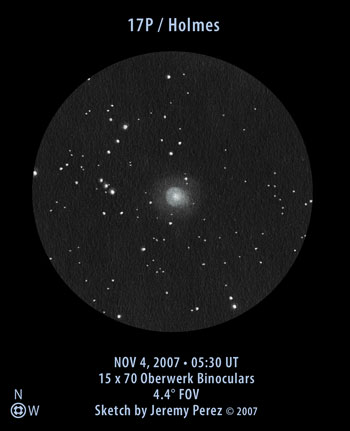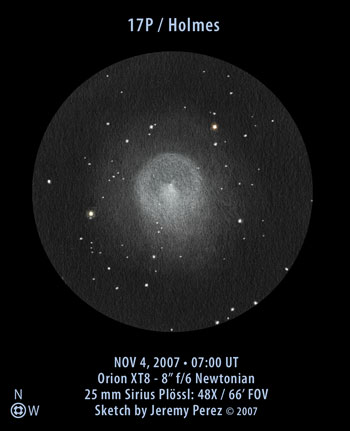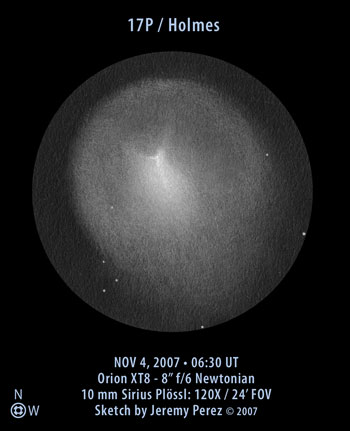
Move mouse over sketch above to view labels. Click image for larger version.

Move mouse over sketch above to view labels. Click image for larger version.

Move mouse over sketch above to view labels. Click image for larger version.
Observation Notes:
After another two day hiatus, I enjoyed some more extended observing of 17P/Holmes. Based on some suggestions from John Bortle, I’m changing my descriptions a bit. What I’ve called the coma I’m going to now call the inner envelope, and what I was calling the outer halo, I will now call the outer envelope. Anyway, the comet is of course larger, and to the naked eye, appears to be a bit brighter than a couple nights ago. The best view is through binoculars, where it is a stunning aqua-colored orb amid the brilliant stars of Perseus. The view makes me think of a mesmerizing tank of jellyfish on display at the Aquatic Center in Maui. The jellyfish were lit by a blue light, that made them appear completely alien and beautiful. The comet reminded me of one of those glowing jellyfish tonight.
The southwest side continues to get softer, with brightening extending in that direction into the outer envelope. Deep inside the coma, in the vicinity of the central condensation, things appear to be shifting around somewhat. The mass of the central condensation seems to be heaving over to the east side of the inner envelope. Some irregularities in the profile of this feature can be seen in the 120X sketch above.
My measurements with the astrometric eyepiece are as follows:
- Central Condensation: 184 x 286 arc seconds / 3.1 x 4.8 arc minutes
- Inner Envelope: 816 x 1020 arc seconds / 13.6 x 17 arc minutes
- Outer Envelope: 2400 arc seconds / 40 arc minutes
| Subject | 17P / Holmes |
| Classification | Comet |
| Position* | 06:30 UT – Perseus: [RA: 03:42:31.2 / Dec: +50:37:09] |
| Size | Central condensation: 184 x 286 arc seconds / 3.1 x 4.8 arc minutes Inner Envelope: 816 x 1020 arc seconds / 13.6 x 17 arc minutes Outer Envelope: 2400 arc seconds / 40 arc minutes |
| Brightness* | ~ 2.4 vMag |
| Date/Time | November 3, 2007, 10:30 – November 4, 2007, 12:00 AM (November 4, 2007, 05:30 – 07:00 UT) |
| Observing Loc. | Flagstaff, AZ – Home |
| Instrument | Orion XT8 (203 mm dia./1200 mm F/L) / 15 x 70 Oberwerk Binoculars |
| Eyepieces/Mag. | 25 mm Sirius Plössl (48X) 10 mm Sirius Plössl (120X) 12 mm Meade Astrometric (~100X) |
| Conditions | Clear, calm |
| Seeing | 4/10 Pickering |
| Transparency | Mag 6.0 NELM |
| *Sources | Aerith.net; Starry Night Pro Plus 5 |
*Based on published data.
Hi Jeremy,
Keep up the great work! I have been using your sketches to compare with my visual experiences (in binoculars and scopes), so thanks. 🙂
Thanks Julian, and you are welcome. I’m glad you’ve been able to use the sketches as a reference. I’m hoping they’ll remind me what this amazing comet looked like and how it developed.
Hi,
I’ve always enjoyed sketching objects (you can see my sketches on my “My Astronomy” page on my website) and have been really thrilled by yours. I’ve only had the chance to view one comet so far (103P/Hartley II) and liked your depictions of it. I also had the chance to recently sketch the Supernova 2011B in NGC 2655. Keep up the good work!
Clear Skies,
Brandon Doyle
Brandon, thanks for the comment on the sketch. Your work is excellent! I always enjoy seeing the latest. Keep up the great work.
Jeremy